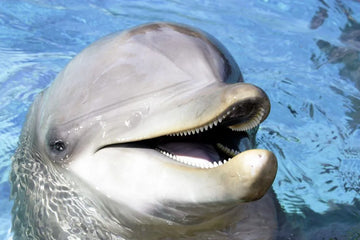The bottlenose dolphin or Tursiops truncatus is a cetacean mammal. It is perhaps one of the most well-known cetaceans, owing to its extensive use in marine parks and research centers. To distinguish this dolphin from others of its species, one simply needs to observe its robust body and its short, broad nose (hence the nickname "bottlenose").
Did you know we have a collection of dolphin t-shirts and hoodies? Don't miss out, top quality and worldwide shipping. A perfect way to show your love for the ocean.
The bottlenose dolphin has great flexibility in its neck as 5 of the 7 neck vertebrae are not fused, unlike other oceanic dolphins. This feature, combined with its great intelligence and friendly nature, has made them the favorites of park and zoo owners, allowing them to perform more acrobatics and learn more tricks.
 Bottlenose dolphins are, after humans, the smartest animals on the planet. Source
Bottlenose dolphins are, after humans, the smartest animals on the planet. SourceThese dolphins, which have between 18 to 26 pairs of sharp, conical teeth on each side of the jaw, are generally light gray on the upper part of the body with pale grays, and rosier on the abdomen. The dorsal fin, located near the center of the back, is high and curved. Their pectoral fins are wide and curved with a medium-depth notch.
The length of adult specimens ranges from 2.5 to 4 meters, reaching a weight of up to 650 kg. Males are significantly larger than females. Bottlenose dolphins are strong and agile mammals that reach maximum speeds of 21 knots (35 km/h).
Bottlenose dolphins work in teams to catch their prey
Bottlenose dolphins hunt both individually and as a team, using echolocation to find large shoals of fish to feed on. Fish are the main part of their diet, but they also include squids and various crustaceans, needing 15 kilos of food daily.
Bottlenose dolphins are found in temperate and tropical waters worldwide in groups of up to 10 or 12 individuals. They are commonly seen in ports, bays, lagoons, estuaries, and river mouths. They often ride the wake left by ships and, at times, approach swimmers and allow them to play with them.
The bottlenose dolphin population remains quite large, but they are on the verge of depletion in some areas, although neither direct nor accidental exploitation threatens the survival of these dolphins in our seas and oceans. The majority of direct deaths of bottlenose dolphins have traditionally occurred in the Black Sea, where Russian and Turkish hunters have drastically reduced local populations. Bottlenose dolphins continue to be accidentally caught in different types of fishing nets, primarily through trawling nets.





















